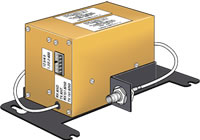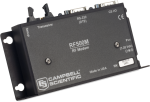
| Services Available | |
|---|---|
| Repair | No |
| Calibration | No |
| Free Support | No |
概览
The RF303 is a DRL UHF radio transceiver for customers who will have an FCC-assigned frequency in the range of 403 to 419 MHz. It's programmed to an exact user-specified frequency by Campbell Scientific using special software.
图像

相似产品
技术说明
NOTE: The RF300-series transceivers are still available for customers who already own RF300-series transceivers, but for newer radio customers, the RF310-series is usually a better choice.
The RF303 is a Dataradio 3412-210 UHF radio transceiver for customers who have an FCC-assigned frequency in the range of 403 to 419 MHz. The transceiver is programmed to an exact user-specified frequency by Campbell Scientific using special software.
Besides the radio, each field station and repeater station must also have an RF500M Radio Modem or RF95(A) Radio Modem; base stations need an RF500M radio modem, RF500B base station, or RF232(A) base station.
产品规格
- Power Output: 5 W at 13.3 V nominal
- Frequency Control: Synthesized
- Channel Spacing: 12.5/25 kHz
- Operation Voltage: 13.3 Vdc nominal
(10 to 16 Vdc operational) - Current Drain:
50 mA quiescent,
~ 1.5 A while transmitting - Dimensions:
11.7 x 8.4 x 5.6 cm
(4.6" x 3.3" x 2.2") - Operating Temperature:
-30° to +60°C - Humidity: 95% maximum RH at 40°C, non-condensing
兼容性
Please note: The following shows notable compatibility information. It is not a comprehensive list of all compatible products.
数据采集器
| Product | Compatible | Note |
|---|---|---|
| 21X (retired) | ||
| CR10 (retired) | ||
| CR10X (retired) | ||
| CR200X (retired) | ||
| CR206X (retired) | ||
| CR211X (retired) | ||
| CR216X (retired) | ||
| CR23X (retired) | ||
| CR295X (retired) | ||
| CR3000 (retired) | ||
| CR500 (retired) | ||
| CR5000 (retired) | ||
| CR510 (retired) | ||
| CR800 (retired) | ||
| CR850 (retired) | ||
| CR9000 (retired) |
Additional Compatibility Information
Radios, Radio Modems, and Radio Base Stations
The RF303 is compatible with the RF500M radio modems, RF500B base stations, RF95(A) radio modems, RF232(A) base stations, E.F. Johnson-series radios, and P50-series radios. The RF303 is NOT compatible with the RF310M radio modem, RF310B Base Station, and RF310-series radios.
常见问题解答
RF303: 1
-
It is possible to connect two antennas to a single radio via a properly specified (operating frequency and power handling capability) two-way, 50 ohm RF power divider. One example of this type of power divider is offered by Pasternack. Note that using a device like this will induce additional losses into the system (3 to 4 dB, typically).
